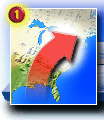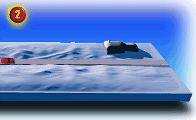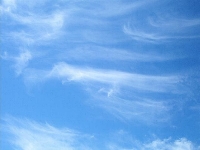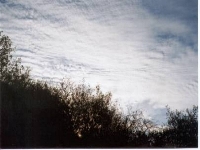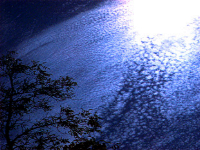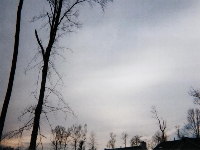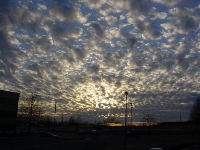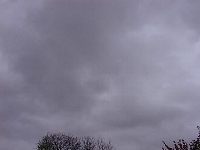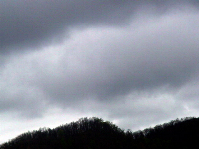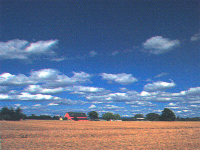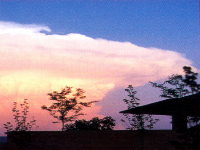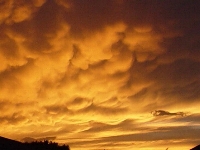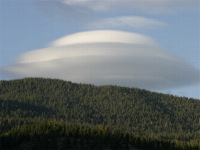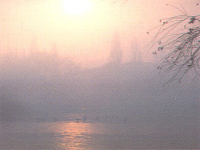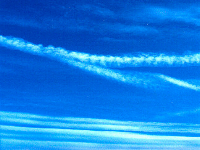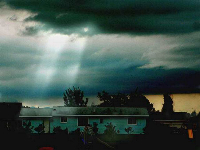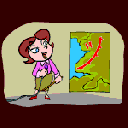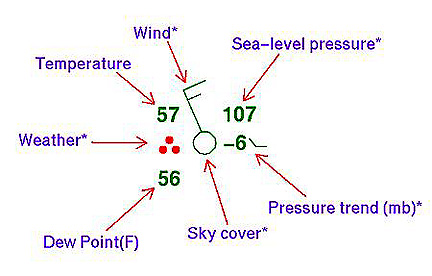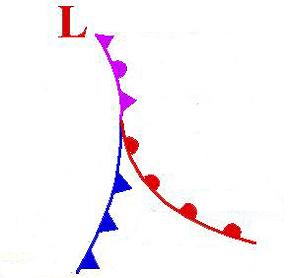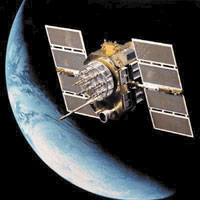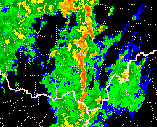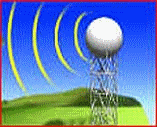Weather Words
A B C D E F G H I J K L M N O P Q R S T U V W X Y Z
Advisory - A forecast issued by the National Weather Service to highlight conditions that require caution, but are not thought to be immediately life threatening.
Air - The mixture of gases, which form the atmosphere of the Earth.
Air Pollution – Chemicals or substances in the atmosphere that are directly or indirectly harmful to living things.
Air Pressure - The weight of air pressing down on earth. Air pressure can change from place to place, and this causes air to move, flowing from areas of high pressure toward areas of low pressure. It’s the same as barometric pressure.
Alberta Clipper - A fast-moving low pressure system that occurs during the winter and sweeps southeast from Alberta, Canada, across the northern Great Plains and Midwest of the United States. These storms usually bring a few inches of snow.
Almanac - A calendar that uses astronomical information and weather data. Almanacs list tide data, give the positions of the stars and forecast weather each day.
Alto - A prefix to cloud-type names for clouds generally found between 3000 and 7000 meters. Alto comes from the Latin word meaning "middle".
Anemometer - A weather instrument that measures the wind speed.
Anticyclone - A high-pressure system that moves in a clockwise motion. These bring you sunny skies.
Arctic Air - An air mass that originates over Canada and brings us cold temperatures.
Atmosphere - A layer of gases surrounding a planet. The Earth’s atmosphere is divided into five layers: exosphere, thermosphere, mesosphere, stratosphere, and troposphere.
Aurora Borealis - It’s often called the "northern lights". It occurs 50 to 100 miles above the earth, when energetic particles from a solar storm cause the gases in the upper atmosphere to glow. Auroras can last between a few minutes to several hours. It’s common across Alaska and northern Canada.
Autumn - The season of the year that occurs after summer and before winter. Autumn officially begins in late September.
Avalanche - A large body of snow, ice or rock and debris sliding down a mountain. Worldwide, about one million snow avalanches occur per year.
Backing Wind - A wind that changes its direction in a counter clockwise motion. For example, a northwest wind changing to a west wind.
Barometer - An instrument that measures air pressure.
Barometric Pressure - It’s the same as air pressure. The pressure exerted by the atmosphere at a given point.
Beaufort Wind Scale - A system of estimating and reporting wind speeds. It is based on the Beaufort Force or Number, which is composed of the wind speed, a descriptive term, and the visible effects upon land objects and/or sea surfaces. The scale was devised by Sir Francis Beaufort (1777-1857), hydrographer to the British Royal Navy.
Bermuda High - It’s a weather system that often dominates the eastern United States during the summer. A semi-permanent subtropical high-pressure system over the North Atlantic Ocean brings in warm and humid air for many days or weeks at a time. It gets its name because it is sometimes centered near Bermuda. It contributes to U.S. heatwaves when it extends west into the Gulf of Mexico and across the Deep South.
Blizzard - An intense winter storm with winds of 35 m.p.h. or higher with falling and/or blowing snow to reduce visibility below 1/4 mile for at least three hours.
Blowing Snow Advisory - When wind driven snow reduces the surface visibility causing dangerous driving conditions. Blowing snow can be falling or snow that has already accumulated on the ground but is picked up and blown by strong winds.
Breeze - A light wind.
Ceiling - The height of the lowest layer of broken or overcast cloud layer.
Cirro - A prefix to cloud-type names for clouds that are at high altitudes and composed of ice crystals.
Cirrus Clouds - Thin, wispy clouds that form high in the atmosphere as their water vapor freezes into ice crystals. Cirrus clouds are a principle cloud type.
Clear Sky - When the sky has no clouds.
Climate - It describes the average weather conditions in a certain place or during a certain season. Weather may change from day to day, but climate changes only over hundreds or thousands of years. Many animals and plants need one kind of climate to survive. Dolphins and palm trees can live only in a warm climate, while polar bears and spruce trees need a cold climate.
Clouds - A visible collection of tiny water droplets or, at colder temperatures, ice crystals floating in the air above the surface. Clouds come in many different sizes and shapes. Clouds can form at ground level, which is fog, at great heights in the atmosphere, and everywhere in between. Clouds offer important clues to understanding and forecasting the weather.
Coastal Flooding - It’s when winds and/or tides cause a rise in the sea level that floods coastal areas.
Coastal Flood Warning - Land areas along the coast are expected to become, or have become, inundated by sea water above the typical tide action.
Coastal Flood Watch - The possibility exists for the inundation of land areas along the coast within the next 12 to 36 hours.
Cold Front - A boundary between two air masses, one cold and the other warm, moving so that the colder air replaces the warmer air.
Condensation - The change of water vapor to liquid water, as when fog or dew forms.
Contrails - Long, narrow, ice-crystal clouds that form behind jet planes flying at high altitudes in below-freezing temperatures. They result from the condensation of water vapor remaining in jet exhaust.
Convection - Motions in a fluid that transport and mix the properties of the fluid. These properties could be heat and/or moisture. When used to imply only upward vertical motion, it is then the opposite of subsidence.
Coriolis Force - A force that deflects moving objects to one side because of the Earth’s rotation. The object is still going straight but the Earth moves underneath it, making it look like it is moving to one side. In the Northern Hemisphere, the Coriolis Force deflects objects to the right.
Cumulonimbus - A dense and vertically developed cloud that produces thunderstorms. The cloud can bring heavy showers, hail, lightning, high winds and sometimes tornadoes.
Cumulus Clouds - Fluffy, mid-level clouds that develop in towering shapes and signal fair weather. Cumulus clouds are a principle cloud type.
Cyclone - A low pressure system. It is a term variously applied to tornadoes, waterspouts, dust storms, hurricanes and even to any strong wind.
Dense Fog - Its fog that reduces horizontal visibility to 1/4 mile or less. Dense fog usually creates traveling problems and delays.
Dense Fog Advisory - It’s issued when dense fog covers a widespread area and reduces visibility to ¼ of a mile or less.
Dew - Water that forms on objects close to the ground when its temperature falls below the dew point of the surface air.
Dew Point - The temperature at which water starts to condense out of a particular air mass. The dew point temperature changes only when the moisture content of the air changes. The higher the dew point, the greater the moisture content is in the air.
Disturbance - A low pressure system, a tropical area of storminess, or any area in which the weather is in a state of cloudiness, precipitation or wind.
Downburst - A strong downward rush of air, which produces a blast of damaging, winds on or close to the surface.
Drifting Snow - An uneven amount of snowfall or existing snow on the ground caused by strong winds. Drifting snow can be very dangerous for drivers.
Drizzle - Light rain consisting of water droplets that are very small.
Drought - A period when a region has a lack of rainfall. Droughts can affect a fairly small area for a season or an entire continent for years. Too little rainfall can cause shortages in the water supply, destroy crops, and cause widespread hunger. Droughts also dry up soil, which then gets picked up by the wind and causes dust storms.
Dry Line - A boundary that separates warm, dry air from warm, moist air. The differences in the two air masses may be significant. The dry line is usually a boundary where thunderstorms form.
Dust Devil - Small whirlwinds of dust that form in dry areas like deserts. They may look like tornadoes, but dust devils are not formed by thunderstorms and do not drop from the sky. Dust devils are caused by swirling winds that rise with the warm air found over the ground.
Earth - The third planet from the sun and is our home.
Earthquake - The shaking or movement of a portion of the Earth's surface.
El Niño - The unusual warming of the surface waters of the eastern tropical Pacific Ocean. It causes changes in wind patterns that have major effects on weather all across the globe.
Environment - The external conditions and surroundings, especially those that affect the quality of life of plants, animals and human beings.
Equator - The imaginary great circle of 0 degrees latitude on the Earth's surface, separating the Northern Hemisphere from the Southern Hemisphere.
Erosion - The wearing away of the Earth’s surface by the action of the sea, running water, moving ice, precipitation or wind.
Evaporation - The process of changing a liquid (like water) to a vapor. It’s the opposite of condensation.
Excessive Heat Warning - It’s issued within 12 hours of the onset of the heat conditions listed in the excessive heat watch.
Excessive Heat Watch - It’s issued when the following conditions occur within 12-36 hours: a heat index of at least 105 degrees for more than 3 hours per day for 2 consecutive days or a heat index more than 115 degrees for any period of time.
Flash Flood - Sudden flooding that occurs when floodwaters rise swiftly with no warning within several hours of an intense rain. They often occur after intense rainfall from slow moving thunderstorms. In narrow canyons and valleys, floodwaters flow faster than on flatter ground and can be quite destructive.
Flash Flood Warning - It’s issued to alert the public, emergency management, and other cooperating agencies that flash flooding is in progress or is likely to happen.
Flood - It results from days of heavy rain and/or melting snows, when rivers rise and go over their banks.
Flood Plain - The lowland that borders a river, usually dry but subject to flooding when the river is high.
Flood Stage - The level at which a stream, river or other body of water begins to or will begin to leave its banks.
Fog - A cloud on the ground that reduces visibility.
Freeze - It occurs when the temperature falls below 32 degrees over a large area for an extended period of time.
Freeze Warning - It’s issued during the growing season when the temperature falls below 32 degrees over a large area for an extended period of time. A freeze can destroy crops.
Freezing Rain - Rain that falls in liquid form but freezes upon impact to form a coating of glaze on the ground and on exposed objects.
Front - A boundary between two different air masses, resulting in stormy weather. A front usually is a line of separation between warm and cold air masses.
Frost - White ice crystals that form on a surface, like the ground or leaves of a plant. Frost is created when the air temperature drops below freezing and the water vapor in the air freezes into ice crystals.
Frost Advisory - It’s issued during the growing season when a widespread frost is expected over an extensive area. Temperatures are usually in the mid 30’s.
Frostbite - It happens when you have excessive exposure to extremely cold weather. It usually affects the toes, fingers, ears, and tip of the nose. Frostbite is rendered more dangerous because there is no sensation of pain, and the victim may not even know that they have been frostbitten.
Fujita Scale - The scale that measures the strength of tornadoes based upon wind speed.
F0: winds 40-72 m.p.h. - (Light damage) Branches broken off trees
F1: winds 73-112 m.p.h. - (Moderate damage) Trees snapped and mobile home pushed off foundations
F2: winds 113-157 m.p.h. - (Considerable damage) Mobile homes demolished and trees uprooted
F3: winds 158-206 m.p.h. - (Severe damage) Trains overturned and cars lifted off the ground
F4: winds 207-260 m.p.h. - (Devastating damage) Houses leveled and cars thrown some distance
F5: winds 261-318 m.p.h. - (Incredible damage) Houses lifted and thrown some distance
Funnel Cloud - A tornado that doesn’t reach the ground. It has a rotating cone-shaped column of air extending downward from the base of a cumulonimbus or thunderstorm cloud, but whose circulation does not make contact with the ground.
Glacier - A large piece of ice that survives for many years, slowly carving out the face of earth.
Glaze - A coating of ice, usually clear and smooth, formed on exposed objects by the freezing of rain, drizzle, or fog.
Global Warming - The theory that increased concentrations of greenhouse gases are causing the Earth’s surface temperature to warm.
Greenhouse Effect - The heating effect of the Earth's atmosphere. The atmosphere acts like a greenhouse because sunlight freely passes through it and warms the surface, but the Earth's re-radiated heat is slowed in its escape from the planet back into space.
Ground Clutter - A pattern of radar echoes from stationary objects like buildings near the radar site. Ground clutter can hide or confuse precipitation echoes near the radar antenna.
Ground Fog - A shallow layer of fog on the ground that reduces visibility more in the horizontal than in the vertical.
Gulf Stream - A warm swift current in the Atlantic Ocean that flows from the Gulf of Mexico along the eastern coast of the United States and then northeast toward Europe.
Gustnado - It’s just a gust front tornado. It’s a small and weak tornado that occurs along the gust front of a thunderstorm and doesn’t stay on the ground for long periods of time.
Hail - A mixture of liquid and frozen precipitation. Hailstones are composed of layers of ice and can become quite large when strong gusts of upward-moving air keep them inside the cloud. As they move around inside the cloud they collide with raindrops, adding layers and growing before they fall to earth.
Hard Freeze - A freeze when the air temperature is 26 degrees or colder for at least four consecutive hours. It usually means that seasonal vegetation will be destroyed.
Haze - Tiny particles of dust, smoke, salt or pollution droplets that are scattered through the air. The particles are too small to be seen or felt individually, but they diminish visibility.
Heat Advisory - It’s issued within 12 hours of the onset of the following conditions: a heat index of at least 105 degrees but less than 115 degrees for less than 3 hours per day or if nighttime lows remain above 80 degrees for 2 consecutive days.
Heat Index - It’s the ‘feel like’ temperature on a hot day. The heat index is a number that expresses the warming effect of humidity at different temperatures. Only air temperature and relative humidity are used in the calculation of heat index.
Heat Lightning - There is no such thing as heat lightning. Heat lightning is just ordinary lightning, except that it is too far away for its thunder to be heard or the cloud producing it to be seen.
Heavy Snow Warning - It’s issued when a snowfall totaling 6 inches or more in 12 hours or less is expected. Also, it’s issued when there is 8 inches or more of snow in 24 hours or less.
High Pressure System - A whirling mass of cool, dry air that generally brings fair weather and light winds. When viewed from above, winds spiral out of a high-pressure center in a clockwise rotation in the Northern Hemisphere. These bring sunny skies.
High Wind Warning - It’s issued when winds of 40 mph or greater are occurring or expected to occur for at least one hour. It also occurs if winds of 58 mph or greater are expected.
High Wind Watch - It’s issued when conditions are favorable of the development of high winds.
Humidity - The amount of water vapor in the air.
Hurricane - They are intense storms with swirling winds up to 150 miles per hour. Usually around 300 miles across, hurricanes are 1,000-5,000 times larger than tornadoes. Hurricanes are known by different names around the world. In Japan they are Typhoons, while Australians call them Willy-Willys.
Hurricane Season - A six-month period from June 1 to Nov. 30, when conditions are favorable for hurricane development.
Hygrometer - An instrument that measures the water vapor content of air or the humidity.
Ice - A water substance in the solid phase.
Ice Storms - They occur when temperatures below a raining cloud are very cold, causing the raindrops to become supercooled (less than 32 degrees Fahrenheit). Freezing rain covers streets, houses, and trees with heavy layers of ice, causing concern for dangerous driving, and damage from the weight of the ice.
Ice Storm Warning - It’s issued when damaging accumulations of ice are expected during a freezing rain event.
Indian Summer - A warm, tranquil spell of weather in the autumn, especially after a period of cold weather. The term is used most often in the Midwest and New England.
Inversion - A layer in the atmosphere where the temperature increases with height.
Isobar - A line connecting equal points of pressure.
Jet Stream - A strong high level wind found in the atmosphere that can reach speeds in excess of 200 mph, usually occurring 6 to 9 miles above the ground. These winds often steer the movement of surface air masses and weather systems.
La Niña - A widespread cooling of the surface waters of the eastern tropical Pacific Ocean. It’s the opposite of El Niño.
Lake Effect Snow - Localized snow that forms on the downwind side of large lakes. It’s common in the late fall and winter in the Great Lakes region when cold, dry air picks up moisture from the unfrozen lake surfaces.
Latitude - The position of the Earth’s surface north or south of the equator.
Leeward Side - The side of an object that is facing away from the direction that the wind is blowing.
Lightning - An enormous and very hot spark of electricity produced by thunderstorms. The lightning bolt itself can heat the air through which it travels to 54,000° F.
Longitude - The position of the Earth’s surface east or west of the Greenwich meridian.
Low Pressure System - A whirling mass of warm, moist air that generally brings stormy weather with strong winds. When viewed from above, winds spiral into a low-pressure center in a counterclockwise rotation in the Northern Hemisphere.
Macroburst - A large downdraft of air with an outflow diameter of 2.5 miles or greater and damaging winds lasting from 5 to 20 minutes. This may reach tornado intensity.
Microburst - A small downdraft of air with an outflow diameter of less than 2.5 miles with the peak winds lasting from 2 to 5 minutes. This can effect a planes performance.
Meridional Flow - It’s when the winds in the upper levels of the atmosphere blow from a North to South component which usually creates a buckling effect in the jet stream.
Meteor - It’s a shooting star. The brief streak of light as an object from space plunges into the Earth's atmosphere.
Meteor Shower - An event when hundreds of meteors or shooting stars appear in the sky at a specific time.
Meteorite - It's a meteor that reaches the Earth's surface.
Meteorologist - A scientist who studies and predicts the weather. Meteorologists use sophisticated equipment, like Doppler radar and supercomputers, but they also rely on old-fashioned sky watching.
Meteorology - The study of the atmosphere and all its phenomena, including weather and how to forecast it.
Mist - Water droplets so small that they are floating in the air. Because mist droplets do not fall, mist is a type of fog.
Monsoon - A seasonal wind, found especially in Asia that reverses direction between summer and winter and often brings heavy rains.
Muggy - The description of warm and humid air.
National Hurricane Center - They issue watches, warnings, forecasts, and analyses of hazardous tropical weather.
National Weather Service - The federal agency that provides weather, hydrologic, and climate forecasts and warnings for the United States.
Nexrad - It’s the "NEXt generation weather RADar", a nationwide network of 120 Doppler radars being used by National Weather Service meteorologists to detect precipitation, to measure atmospheric motions and to issue warnings of severe weather.
Nimbus - The Latin word for "rain" used to describe a cloud or group of clouds from which rain is falling.
Nor'easter - A powerful low-pressure system that moves north along the Atlantic Coast. It’s called a Nor’easter because the coastal winds are from the northeast. Heavy rain, snow and high surf often occur.
Occluded Front - A combination of two fronts that form when a cold front catches up and overtakes a warm front.
Overcast - When a widespread layer of clouds covers all of the sky. There may be thin or bright spots in the cloud layer, but no openings.
Overrunning - A condition that happens when an air mass moves up and over a denser air mass on the surface. This creates low clouds, fog and steady, light precipitation.
Ozone - A form of oxygen that has a weak chlorine odor. Ozone heats the upper atmosphere by absorbing ultraviolet from sunlight. In the troposphere, ozone is a pollutant, but in the stratosphere it filters out harmful ultraviolet radiation.
Precipitation - General name for water in any form falling from clouds. This includes rain, drizzle, hail, snow and sleet. Although, dew, frost and fog are not considered to be precipitation.
Radar - An electronic instrument, which determines the direction and distance of objects that, reflect radio energy back to the radar site. This is what meteorologists use to see rain or snow.
Rain - Liquid precipitation in the form of water drops that falls from clouds for several hours.
Rainbow - They are one of the most common but most spectacular sky displays. Rainbows are caused by the reflection and refraction (bending) of sunlight passing through raindrops. In heavy rains a double rainbow can often be seen. The sequence of a rainbows color is red, orange, yellow, green, blue, indigo and violet.
Rain Gauge - An instrument used to measure the amount of rain that has fallen. Measurement is done in hundredths of inches (0.01").
Relative Humidity - The ratio of water vapor contained in the air compared to the maximum amount of moisture that the air can hold at that specific temperature and pressure.
Ridge - It’s an elongated area of high pressure.
Saffir-Simpson Scale - A hurricane intensity scale that relates hurricane damage to wind speeds and central air pressures.
Category 1: wind speeds 74-95 m.p.h.
Category 2: wind speeds 96-110 m.p.h.
Category 3: wind speeds 111-130 m.p.h.
Category 4: wind speeds 131-155 m.p.h.
Category 5: wind speeds over 155 m.p.h.
Sandstorm - A strong wind which carries sand through the air. Usually occurs in desert regions, often among sand dunes.
Seasons - The earth's position in relation to the sun is always changing. The earth spins around its axis, an imaginary line that runs between the north and south poles. One complete spin takes 24 hours, and at any moment, half of the earth is lit and warm (day), while the other half faces away from the sun (night). While it spins the earth also moves around the sun in a circle, called an orbit, and the orbit takes one year to complete. As the earth moves and spins it is tilted in one direction at an angle of 23 degrees. It stays tilted all the time as it orbits the sun, so that each area of earth receives different amounts of the sun's energy at different times of the year. This is why we have seasons.
Sea Breeze - An daytime coastal breeze that blows onshore, from the sea to the land. It is caused by the temperature difference when the surface of the land is warmer than the adjacent body of water. Predominate during the day, it reaches its maximum early to mid afternoon. It blows in the opposite direction of a land breeze.
Severe Thunderstorm - A thunderstorm with winds of 58 mph or greater and/or with hail ¾ inch in diameter or larger.
Severe Thunderstorm Warning - It’s issued to warn the public, emergency management, and other cooperating agencies when a severe thunderstorm is forecast to occur or is occurring. The warning will include where the storm was occurring, its direction of movement and the primary threat from the storm.
Severe Thunderstorm Watch - It’s issued when conditions are favorable for the development of severe thunderstorms.
Severe Weather - Its any kind of destructive or life-threatening weather event. Thunderstorms that can be destructive, while tornadoes, high winds, hail, excessive rainfall and lightning can be life threatening.
Showers - It’s just rain falling from the sky causing puddles to form on the ground.
Shear - It’s just a variation in the wind speed and/or direction over a short distance.
Shortwave - It’s basically a trough. It’s an elongated area of low pressure. These can form stormy weather.
Sleet - Solid precipitation in the form of ice pellets form when raindrops, originating in warmer air aloft, freeze as they fall through subfreezing air near the surface of the Earth.
Sleet Warning - It’s issued when accumulations of sleet in excess of a half inch are expected. This is very rare.
Slush - It’s snow or ice on the ground that has been reduced to a soft, watery mixture by rain or warm temperatures.
Small Craft Advisory - A small craft advisory is a type of warning issued by the National Weather Service, most frequently in coastal areas. It is issued when winds have reached, or are expected to reach within 12 hours, a speed marginally less than that which is considered gale force, usually 25-38 mph.
Smog - It’s visible air pollution in urban areas. It looks like dirty fog in large cities.
Snow - Precipitation that is composed of white ice crystals that fall from clouds. Snow may stick together to form snowflakes, which have a hexagonal or six-sided shape.
Snow Accumulation - The actual depth of snow on the ground at any instant. This occurs during or after a snowstorm storm.
Snow Advisory - It’s issued when a snowfall is expected to exceed 2 inches but no more than 5 inches.
Snow Flurries - Brief occurrences of very light snow, which produce little or no accumulation.
Snow Showers - Brief occurrences of light to moderate snow, which could produce some snowfall accumulations.
Snowflakes - Packets of falling snow formed when at least a few ice crystals are matted together. The largest snowflakes tend to occur when temperatures are near freezing. Snowflakes have a hexagonal or six-sided shape.
Spring - The season between winter and summer. Spring officially begins in late March and lasts until late June.
Sprinkle - A very light shower of rain just barely wetting the ground.
Squall Line - A line of thunderstorms sometimes several hundred miles long that can produce strong thunderstorms and sometimes severe weather.
Stable Air - Air that is colder than its surroundings and is resistant to upward movement.
Stationary Front - A boundary between two air masses that more or less doesn’t move, but some stationary fronts can wobble back and forth for several hundred miles a day.
Storm - Any disturbed state of the atmosphere that creates unpleasant weather like rain, lightning, thunder, hail, snow, sleet, and freezing rain.
Stratus Clouds - Low-lying, gray and sheetlike clouds that often produce drizzle. Stratus clouds are a principle cloud type.
Strato - A prefix to cloud-type names for clouds generally found low in the atmosphere.
Sublimation - The process of a solid (ice) changing directly into a gas (water vapor), or water vapor changing directly into ice, at the same temperature, without ever going through the liquid state (water).
Summer - The warmest season of the year. Summer officially begins in late June and last until late September.
Sun - It’s responsible for most of the earth's weather, even though it is 93 million miles away. The Sun’s intense heat gives energy to the earth's atmosphere and sets it in motion. The Sun is a star, 868,000 miles across, in the center of our solar system.
Sunrise - The time the sun appears above the horizon.
Sunset - The time the sun disappears below the horizon.
Supercell - A severe thunderstorm whose updrafts and downdrafts are in near balance for several hours. Supercells often produce large hail and tornadoes.
Temperature - The measurement of how hot or cold something is.
Thermometer - The instrument that measures temperature.
Thunder - The explosive sound of air expanding as it is heated by lightning.
Thunderstorm - A storm produced by a cumulonimbus cloud and always has lightning and thunder. Rain, hail and high winds may or may not occur.
Tide - The regular rise and fall of the Earth's oceans caused by the actions of the moon's and sun's gravitation acting on the rotating Earth.
Tidal Range - The difference in water level between high tide and low tide at a given place.
Tidal Wave - A destructive and high rise of water along a seashore. Tidal waves are caused by underwater earthquakes, volcanoes or landslides, and have nothing to do with tides.
Tornado - It begins as a funnel cloud with spinning columns of air that drop down from a severe thunderstorm. When they reach the ground they become tornadoes. Tornadoes are between 300 and 2,000 feet wide and travel at speeds of 20 to 45 miles per hour. They usually only last a few minutes, but their spinning winds, up to 300 miles per hour, can lift houses into the air and rip trees from the ground.
Tornado Warning - It’s issued to warn the public, emergency management, and other cooperating agencies when a tornado is forecast to occur or is occurring. The warning will include where the storm was occurring and where it’s expected to travel.
Tornado Watch - It’s issued when conditions are favorable for the development of tornadoes.
Tornado Alley - The portion of the United States where tornadoes occur most frequently. Tornado alley is between the Plains area from the Rocky Mountains on the west to the Appalachian Mountains on the east.
Trade Winds - Winds which blow from tropical high pressure belts toward the equatorial region of low pressure. In the Northern Hemisphere, the trade winds blow from the northeast.
Transpiration - The process by which water in plants is transferred as water vapor to the atmosphere.
Tropical Storm - It’s a low-pressure disturbance that forms over warm tropical ocean waters. In the United States, a tropical storm has winds between 39-73 m.p.h.
Tropical Depression - It’s a low-pressure disturbance that forms over warm tropical ocean waters and produces winds of 38 m.p.h. or less.
Troposphere - It’s the lowest portion of Earth's atmosphere. It contains approximately 75% of the atmosphere's mass and 99% of its water vapor and aerosols. Day to day weather occurs in the troposphere.
Trough - It’s an elongated area of low pressure.
Tsunami - A Japanese term for an unusually large ocean wave caused by undersea earthquake, landslide, or volcanic eruption. Only a few inches high in the open ocean, tsunamis steepen and rise in shallow water and can reach heights of 200 feet.
Typhoon - A hurricane in the western Pacific Ocean.
Unstable Air - Air that is warmer than its surroundings and tends to rise, leading to the formation of clouds and precipitation.
Veering Wind - A wind that changes its direction in a clockwise motion. For example, a west wind changing to a northwest wind.
Virga - Rain or snow that falls from a cloud but evaporates before it reaches the ground.
Visibility - The greatest distance that is possible for a person to see with their eyes. When fog occurs, a persons visibility is lowered.
Volcano - It’s any place where lave, ash or volcanic gases escape to the surface. Volcanoes come in all kinds of shapes and sizes.
Wall Cloud - It’s an area of clouds that extends underneath a thunderstorm. If a wall cloud rotates, it might form a tornado.
Warm Front - The boundary between two air masses, one cool and the other warm, moving so that the warmer air replaces the cooler air.
Warning - A forecast issued by the National Weather Service indicating that a specific weather event is actually occurring.
Watch - A forecast issued by the National Weather Service indicating that conditions are favorable for a particular weather hazard.
Water Vapor - It’s a gas in the atmosphere. There is very little of it in the air. Water vapor is only 1 to 4% of the atmosphere, but without it we would have no clouds, rain, or snow. Water vapor is one of the greenhouse gases, which help to trap the earth's heat.
Waterspout - A tornado occurring over water.
Weather - It describes the condition of the air at a particular time and place. Weather also tells how the air moves (wind) and describes anything it might be carrying such as rain, snow or clouds. Thunder, lightning, rainbows, haze and other special events are all part of weather.
Whiteout - It results from extreme blizzard conditions in which blowing snow or falling snow reduces visibility so that the sky, air, and ground becomes indistinguishable. Everything appears white and can be extremely dangerous for drivers.
Wind - The movement of air relative to the surface of the earth. It’s considered to be severe if 58 m.p.h. or greater. Hurricane winds are 74 m.p.h or greater and the highest tornado winds are about 318 m.p.h.
Wind Advisory - An advisory from the National Weather Service when the winds are between 29-38 m.p.h. lasting more than one hour, or when wind gusts are between 44-57 m.p.h.
Wind Chill - It’s the ‘feel like’ temperature on a cold day when you factor in the winds.
Wind Chill Factor - It’s a number that expresses the cooling effect of moving air at different temperatures. Only air temperature and wind speed is used in the calculation of wind chill temperatures. A wind chill temperature of 30 degrees below zero or colder on exposed skin can cause frostbite in a very short period of time.
Wind Chill Advisory - It’s issued when winds of 10 m.p.h. or greater are expected to create wind chill factors of 30 degrees below zero or more.
Windward Side - The side of an object that is facing into the direction that the wind is coming from.
Winter - The coldest season of the year. Winter officially begins in late December to late March.
Winter Storm Warning - It’s issued when hazardous winter weather is occurring or is likely over a specific area. Hazardous winter weather includes heavy snows, blizzards, ice storms, freezing rain, freezing drizzle and sleet.
Winter Weather Advisory - It’s issued for winter weather situations that could lead into hazardous conditions.
Zonal Flow - It’s when the winds in the upper levels of the atmosphere blow from coast to coast with little or no deviation. In other words, the jest stream creates a straight line.


